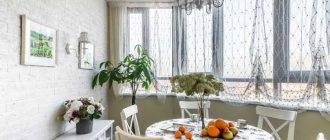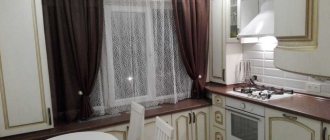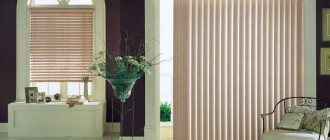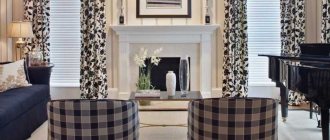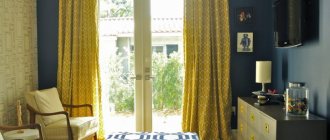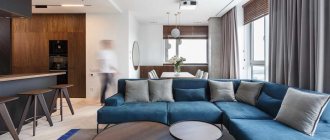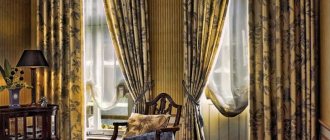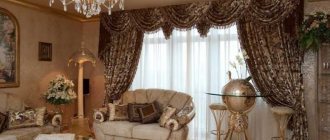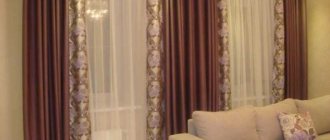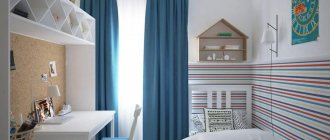Selection rules
Classic style curtains do not tolerate fuss. The design of classic curtains requires preliminary careful measurements and calculations. The choice of paintings must be tailored to each specific window and its size, otherwise the nobility of the finish will lose all meaning.
Wide and tall windows will be gracefully decorated with numerous folds, ruffles, and frills. A smaller room will require less decor.
Small windows will look lovely with curtains in light colors; for a large room you can use richer shades of wine, burgundy, and blue.
The material for classic style curtains can only be natural fabrics. Synthetic fabrics are best left to more modern styles.
Compatibility and appropriateness
Of course, the curtains should become one with the interior appearance of the home. To do this, use several simple techniques:
- Similarity of colors. For example, curtains for a classic-style bedroom can match the color of the bed linen or bedspread. This similarity unites disparate interior details into a single composition.
- Ornament and coloring. The strict style of the living room is combined with the same laconic appearance of the curtains. Children's room implies bright and rich colors of curtains. The design of curtains in the bedroom in a classic style is calm and peaceful, without sharp lines or changes in shades.
- We take into account the dimensions. Complex sets of curtains in cold and dark shades are strictly for large spaces. Yes, such curtains look very rich and beautiful, but they are unacceptable for small rooms and windows. Light and airy curtains correspond to cramped rooms, visually expanding the space.
- We calculate the possibilities. Curtains are an interior attribute that requires constant care. Complex curtains with an abundance of tassels and folds must be frequently dusted and washed, and any stains stand out extremely clearly on light-colored fabrics. It is necessary to choose curtains whose care will not take a critical amount of time and effort.
Signs of classic curtains
The main features of such curtains were and remain the presence of tulle, long opaque panels, the grace of each fold, and sliding panels.
Moreover, the latter can be decorated with tiebacks or used without this decorative element.
Accessories for decorating classic curtains
Classic curtains are decorated with lambrequins and tiebacks, as well as additional decorative elements in the form of beads, rhinestones, and embroidery. Let's take a closer look at all the features of lambrequins and tiebacks for classic curtains.
Lambrequins. Attached to the cornice at the top of the curtains. It is better to attach the lambrequins statically to the eaves so that they do not move when the main curtains move. Lambrequins can be soft or hard. Soft ones are sewn from the same fabric as curtains. They are distinguished by lush folds and draperies, while rigid lambrequins are fabrics placed on a hard lining. The main function of a lambrequin is to hide the cornice, and then decorate the entire curtain fabric. The presence of a lambrequin in the window decoration is not at all necessary, unless the style requires it and the taste preferences of the designer or the owner of the apartment are not directed in their direction; classic curtains can exist perfectly well without them.
Soft lambrequins beautifully frame the upper edge of the window and complete the look as a whole.
Pickups. They give the curtains a neat, finished look. If the curtains consist of two panels, then the tiebacks are usually made from the center to the sides. And when it is one wide curtain, the tie will look different: from the edge to the center, or the entire canvas is collected with a clip in the middle of the window. The function of the grabbers is to open the window as much as possible to allow light from outside to pass through.
Thanks to the tiebacks, the curtains will not hang carelessly and the approach to the window will be freer
Classic curtains
Curtains in the most classic version are long sheets that fall to the floor or barely reach it.
The canvases are complemented by light translucent tulle or delicate organza, slightly gathered into light waves. Such curtains can be gathered at the sides using decorative tiebacks or ties.
What is curtain classics?
Curtains made according to the laws of the classics have the following mandatory elements:
- heavy, massive curtain;
- lambrequins;
- curtain fabric.
Classic curtains are curtains, curtains and lambrequins
The curtain part is usually made from the heaviest fabric with regular geometry and is hung so as to necessarily form vertical folds. A curtain is a part of a composition made of transparent, as light as possible, airy fabric, which is hung under the curtain fabric, acting as a lining for the curtains, highlighting their heaviness. The lambrequin is always located on top of the curtains and is a flounce-shaped decorative element.
Curtains in the classic version always have floor length
Attention! In terms of length, classic curtains must either reach the floor or specifically, thoroughly lie on its plane.
Also, as an addition, they can be decorated with such a device as a scoop with tassels and fringe with gold. Among other things, thick cords, ribbons, ruffles, beads, and ribbons are used.
Tiebacks can be decorated with large tassels
French curtains
Classic French style curtains are complex designs consisting of carefully laid folds, waves, and flounces. Most of all, such curtains are reminiscent of palace interiors or theater halls.
Note!
- Curtains with lambrequin - choice of colors and tones. Features of types of lambrequins. Instructions for sewing lambrequins with your own hands (photo + video)
Greek curtains: TOP 140 photos and video reviews. Choice of material and colors. Features of Greek curtains for different rooms. Installation nuances
Green curtains: features of choosing colors and shades of green. A combination of interior styles with green curtains. Photo and video reviews from designers
Such elements look great on large windows and spacious rooms.
What methods of attaching classic curtains exist?
The method of attaching classic curtains deserves special attention, as it plays a primary role in ensuring reliability and also affects the appearance of the curtains.
Fastening classic curtains Source maax-mebel.ru
The following mounting methods are available:
- Baguette cornices.
- Tubular cornices.
- Profile cornices.
- Forged cornices.
Curtains on a wrought iron cornice Source potolokspec.ru
- Wooden cornices.
- Fastening with eyelets.
- Ring mount.
- Ties.
Curtains with ties Source art-interior.moscow
- Fabric loops.
- Kuliska.
- Braid.
The most suitable for classic curtains is a baguette cornice, since the fasteners will not be visible.
Baguette cornice Source domlegrand.com
But you may want to experiment a little or use the mount not only for practical purposes, but also for decorative ones. In this case, it makes sense to pay attention to other types of fastening and when choosing, be guided by personal taste.
Curtains with rings Source horosho-doma.ru
It is also important that the fastening matches the curtains. The main thing is to choose a high-quality mount that will securely hold the curtains.
Mount compatible with curtains Source karavan39.ru
Roman curtains
Roman-style curtains are a panel that forms folds parallel to the floor. When disassembled, they become a flat canvas that can be mounted both above the window opening and on the glass itself.
They look great even in a small room and wonderfully regulate the amount of light entering the room.
Mounting options
You can secure curtains in a classic style in various ways. As already mentioned, some types are mounted directly on the window opening. But most often cornices are used.
They can be ceiling or wall mounted. Have several rows. Double-row ones are suitable when using curtains with tulle. If you also add a lambrequin, you can purchase a three-row one.
The fabrics are attached to the cornice using hooks, rings, eyelets or loops on the fabric itself.
The color of the fasteners should not be too bright and should not differ radically from the design of the curtains and the room.
Note!
Greek curtains: features of the design and installation of Greek curtains. Selection of fabric in the Greek style, variety of colors and textures (photo + video)Roller blinds - pros and cons of installing roller blinds. Selection of materials, fastenings and types of roller blinds (photo + video)
- Thread curtains: TOP-130 photos + video of curtain options. Application of filament curtains, their types and styles, advantages and disadvantages
Lambrequin
This decorative element is present in almost all classic curtains.
They decorate the space between the ceiling and the window opening. Such an element is a rather rigid structure, not adjustable in either height or width.
Note!
Fashionable curtains: TOP-170 photos and video reviews of fashionable curtains. Selection of curtains for different rooms and styles. Fabric and color options- Beige curtains: features of beige shades, rules for color combinations. Choosing an interior style for beige curtains. Types of fabric materials (photo + video)
- Brown curtains: varieties of curtains and curtains. Tips on choosing materials, colors, patterns and sizes of curtains. Brown curtains for different styles (photo + video)
Most often, the lambrequin is made from the same fabric as the main fabric, but sometimes this design becomes a contrasting element of window decoration.
Classic curtains - versatility and practicality
Such window curtains not only suit almost any interior, but also provide residents with a special atmosphere.
Curtains also cover the window space if necessary, which is often necessary for residents of low-rise buildings. Thick fabric reliably protects the apartment from prying eyes and gives household members a feeling of confidence and peace.
Color spectrum
Curtains can be combined in color with the selected decoration of the room or furniture or become a contrasting element, matched only by the pattern.
Curtains in light colors will visually enlarge the room, warm colors will give it additional comfort, but will take up a little space.
The most popular are curtains of all white shades, beige and sand tones, which are often decorated with darker tiebacks, edgings, fringes, and tassels.
Decorating walls using patterns or designs attracts quite a lot of attention; in this case, the curtains should be plain fabrics. Conversely, the monotony of wallpaper or paint will help to dilute curtains with a light pattern.
Note!
Turquoise curtains: advantages and disadvantages of turquoise colors. Rules for combining turquoise curtains with interior elements. Selection of fabric materials (photo + video)Olive curtains: advantages and disadvantages of olive color for curtains. A range of combinations and varieties of shades. Types of olive curtain designs (photo + video)
- Curtains for a small kitchen: TOP-140 photos and videos of curtain options for a small kitchen. Tips for choosing length, number of layers, fabric and colors
Curtains with stripes will certainly draw attention to the windows, while the vertical stripes will raise the ceilings.
Variety of curtains in a classic style
Curtains in a classic style
Modern manufacturers offer a large number of options for classic curtain sets, so there are no problems creating truly unique interiors. What do designers today consider classics of the genre?
- Roman curtains.
- Long curtains.
- French curtains.
- Lambrequin.
Classic style curtains
Roman curtains are strips of fabric that are folded into beautiful wide transverse folds using an opening system. The photo shows that Roman classic curtains can be attached directly to the window frame or cover the window opening completely. It looks aesthetically pleasing in both cases. This type of curtains will be an excellent solution for decorating a small room.
In classic interiors, curtains always have a maximum length. Ideally, they fall to the floor, but it is allowed that the fabrics do not reach it slightly. It is customary to pick up long curtains with decorative ties of various widths and designs and pull them apart, so they are always combined with light curtains that are attached to the cornice, gathered in small waves.
Curtains in a classic style
Look at the photo to see how similar curtains might look in the classic interior of a bedroom and kitchen.
French curtains bring with them a festive atmosphere. They are an ideal solution for decorating wide and tall windows. Stationary structures can act as tulle and be combined with curtains or transformed into a lambrequin, provided there is a lifting mechanism.
Lambrequin is a decorative element and is intended to decorate the cornice area. With its help you can visually increase the height of the window. The variety of lambrequin models allows you to decorate the window opening in an original way and even make it an accent point of the interior.
Material
Classic curtains are characterized by noble fabrics. Most often it is silk, taffeta, satin, brocade, velvet, jacquard. All these fabrics are easy to find in stores. They drape beautifully, shimmer exquisitely in the light, have a pleasant texture, are distinguished by their elegant appearance and long service life.
Advantages
Classic curtains have the following advantages:
- a wide range of;
- versatility;
- relevance over a long period of time;
- luxurious and elegant appearance;
- the ability to make the room feel comfortable;
- the ability to disguise interior imperfections.
Use in various rooms
Luxurious French-style folds or a chic lambrequin with simple fabrics are perfect for the living room.
Translucent Austrian curtains can replace tulle, while the main fabrics can be straight and even curtains or have elegant tiebacks.
Curtains for a classic-style bedroom are usually made from delicate fabrics, mostly elegant blue, elegant cream or soft green shades.
The design of curtains in a classic style bedroom involves the use of simple fabrics and translucent tulle or unusual Roman blinds.
Curtains for a classic kitchen are usually presented in light-colored fabrics or the same Roman curtains. They should not block the light.
It is not recommended to use very long curtains and lush folds in the kitchen. Otherwise, the curtains will have to be washed very often.
For the dining room, thicker curtains in beige or olive colors and elegant tulle are suitable.
A luxurious bathroom in a classic style will be perfectly decorated with roller or Roman fabrics, Austrian curtains in light blue or white colors with patterns.
Most often, the color scheme of classic curtains is matched to the living room carpet, bedroom rug, and kitchen facades.
Photos of classic curtains show this perfectly.
Decorative accessories
The beauty of the classic style lies in the luxury and abundance of richness that the details bring. Curtains are decorated with functional accessories, such as:
- Holders made of wood or metal, which are mounted on the wall, hold the shape of the drapery and decorate the curtains. Also, holders can be magnetic, fabric or ribbon.
The photo shows an example of draping curtains and fixing them using holders. The classic mounting height is window sill level.
- The pickups control the light level, are easy to use, and can be changed frequently. They come in the form of hairpins, beads, fabric, ropes. They differ from holders in that they are not attached to the wall.
- Brushes help give the curtains the desired shape and hold it. Also, small tassels can be used to decorate a lambrequin or the edge of a fabric.
- A lambrequin with numerous flaps is suitable for decorating a window in the living room. It may be made of a different material and a contrasting color; in this case, it is important not to overload the room with other decorative elements.
The photo shows an example of how a lambrequin can decorate not only the living room, but also the kitchen.
- In the classic style, fringe decorates the border of the curtains. It can be of different lengths, with beads, bugles and beads, with tassels and weaving.
